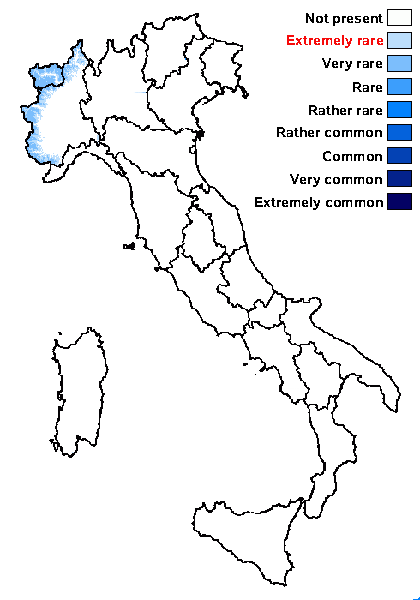Buellia leptolepis Bagl. & Carestia
Comm. Soc. Critt. Ital., 2: 83, 1864.
Synonyms: Karschia leptolepis (Bagl. & Carestia) Arnold; Karschia saxatilis f. leptolepis (Bagl. & Carestia) Kreisel
Distribution: N - Piem (Isocrono & al. 2004), VA (Piervittori & Isocrono 1999).
Description: Thallus crustose, episubstratic, whitish, pale grey or pale grey-brown, consisting of a few, conical, scattered areoles, usually delimited by a black, often fimbriate prothallus, often growing on the thalli of crustose Lecanoraceae. Medulla white, I-, rarely I+ pale blue. Apothecia cryptolecanorine to zeorine, 0.3-0.4 mm across, black, immersed to subsessile, with a mostly flat disc and a thin, usually persistent proper margin. Proper exciple 25-35 µm wide laterally, Aethalea-type, poorly differentiated, the inner hyphae narrow, hyaline, prosoplectenchymatous, the outer hyphae parallel, moderately swollen and usually strongly carbonized with brown and aeruginose pigments reacting N+ violet-red; epithecium olive-brown to green-black, N+ violet-red; hymenium colourless, not inspersed with oil droplets, 60-80 μm high; paraphyses mostly simple, c. 2 µm thick at mid-level, the apical cells clavate, up to 5 µm wide; hypothecium colourless to pale brown. Asci 8-spored, clavate to cylindrical-clavate, the apical dome K/I+ dark blue with a pale, conical-pointed apical cushion (axial mass), the wall I-, but the thin outer gel I+ blue, Bacidia-type. Ascospores 1-septate, not or only slightly constricted at septum, brown, ellipsoid, 9.5-11.5 x 5.5-7.5 µm, Buellia-type, thin-walled throughout. Photobiont chlorococcoid. Spot tests: thallus K+ red (needle-like red crystals), C-, KC-, P- or P+ faintly yellow, UV-. Chemistry: norstictic acid. Note: a parasite of crustose Lecanoraceae, hitherto known from the Alps and Scandinavia. Roux & coll. (2014) treat it as a possible synonym of B. ectolechioides.
Growth form: Crustose
Substrata: rocks
Photobiont: green algae other than Trentepohlia
Reproductive strategy: mainly sexual
paras Myriolecis albescens and other lichens
Commonnes-rarity: (info)
Alpine belt: very rare
Subalpine belt: very rare
Oromediterranean belt: absent
Montane belt: extremely rare
Submediterranean belt: absent
Padanian area: absent
Humid submediterranean belt: absent
Humid mediterranean belt: absent
Dry mediterranean belt: absent

Predictive model
Growth form: Crustose
Substrata: rocks
Photobiont: green algae other than Trentepohlia
Reproductive strategy: mainly sexual
paras Myriolecis albescens and other lichens
Commonnes-rarity: (info)
Alpine belt: very rare
Subalpine belt: very rare
Oromediterranean belt: absent
Montane belt: extremely rare
Submediterranean belt: absent
Padanian area: absent
Humid submediterranean belt: absent
Humid mediterranean belt: absent
Dry mediterranean belt: absent

Predictive model
 INDEX FUNGORUM
INDEX FUNGORUM
 GBIF
GBIF

